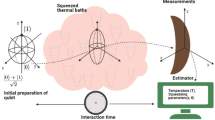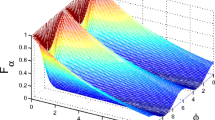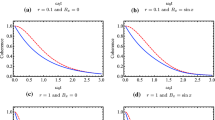Abstract
We study the precision of parameter estimation for dephasing model under squeezed environment. We analytically calculate the dephasing factor γ(t) and obtain the analytic quantum Fisher information (QFI) for the amplitude parameter α and the phase parameter ϕ. It is shown that the QFI for the amplitude parameter α is invariant in the whole process, while the QFI for the phase parameter ϕ strongly depends on the reservoir squeezing. It is shown that the QFI can be enhanced for appropriate squeeze parameters r and θ. Finally, we also investigate the effects of temperature on the QFI.



Similar content being viewed by others
References
Giovannetti, V., Lloyd, S., Maccone, L.: Quantum metrology. Phys. Rev. Lett. 96, 010401 (2006)
Giovannetti, V., Lloyd, S., Maccone, L.: Advances in quantum metrology. Nat. Phot. 5, 222 (2011)
Demkowicz-Dobrzański, R., Kołodyński, J., Guţă, M.: The elusive Heisenberg limit in quantum-enhanced metrology. Nat. Commun. 3, 1063 (2012)
Vallisneri, M.: Use and abuse of the Fisher information matrix in the assessment of gravitational-wave parameter-estimation prospects. Phys. Rev. D 77, 042001 (2008)
Helstrom, C.W.: Quantum Detection and Estimation Theory. Academic Press, New York (1976)
Braunstein, S.L., Caves, C.M.: Statistical distance and the geometry of quantum states. Phys. Rev. Lett. 72, 3439 (1994)
Caves, C.M.: Quantum-mechanical noise in an interferometer. Phys. Rev. D 23, 1693 (1981)
Breuer, H.P., Petruccione, F.: The Theory of Open Quantum Systems. Oxford University Press, New York (2002)
Huelga, S.F., Macchiavello, C., Pellizzari, T., Ekert, A.K., Plenio, M.B., Cirac, J.I.: Improvement of frequency standards with quantum entanglement. Phys. Rev. Lett. 79, 3865 (1997)
Chin, A.W., Huelga, S.F., Plenio, M.B.: Quantum metrology in non-Markovian environments. Phys. Rev. Lett. 109, 233601 (2012)
Escher, B.M., de Matos Filho, R.L., Davidovich, L.: General framework for estimating the ultimate precision limit in noisy quantumenhanced metrology. Nat. Phys. 7, 406 (2011)
Sun, Z., Ma, J., Lu, X.M, Wang, X.: Fisher information in a quantum-critical environment. Phys. Rev. A 82, 022306 (2010)
Humphreys, P.C., Barbieri, M., Datta, A., Walmsley, Ian A.: Quantum enhanced multiple phase estimation. Phys. Rev. Lett. 111, 070403 (2013)
Yue, J.D., Zhang, Y.R., Fan, H.: Quantum-enhanced metrology for multiple phase estimation with noise. Sci. Rep. 4, 5933 (2014)
Ahmadi, M., Bruschi, D.E., Fuentes, I.: Quantum metrology for relativistic quantum fields. Phys. Rev. D 89, 065028 (2014)
Tian, Z., Wang, J., Fan, H., Jing, J.: Relativistic quantum metrology in open system dynamics. Sci. Rep. 5, 7946 (2015)
Wang, J., Tian, Z., Jing, J., Fan, H.: Quantum metrology and estimation of Unruh effect. Sci. Rep. 4, 7195 (2014)
Tan, Q.S., Huang, Y., Yin, X., Kuang, L.M., Wang, X.: Enhancement of parameter-estimation precision in noisy systems by dynamical decoupling pulses. Phys. Rev. A 87, 032102 (2013)
Demkowicz-Dobrzański, R., Maccone, L.: Using entanglement against noise in quantum metrology. Phys. Rev. Lett. 113, 250801 (2014)
Anisimov, P.M.: Quantum metrology with two-mode squeezed vacuum: parity detection beats the Heisenberg limit. Phys. Rev. Lett. 104, 103602 (2010)
Dür, W., Skotiniotis, M., Fröwis, F., Kraus, B.: Improved quantum metrology using quantum error correction. Phys. Rev. Lett. 112, 080801 (2014)
Pezzé, L., Smerzi, A.: Entanglement, nonlinear dynamics, and the Heisenberg limit. Phys. Rev. Lett. 102, 100401 (2009)
Hyllus, P., Laskowski, W., Krischek, R., Schwemmer, C., Wieczorek, W., Weinfurter, H., Pezzé, L., Smerzi, A.: Fisher information and multiparticle entanglement. Phys. Rev. A 85, 022321 (2012)
Joo, J., Munro, W.J., Spiller, T.P.: Quantum metrology with entangled coherent states. Phys. Rev. Lett. 107, 083601 (2011)
Scully, M.O., Zubairy, M.S.: Quantum Optics. Cambridge University Press, Cambridge (1997)
Drummond, P.D., Ficek, Z. (eds.): Quantum Squeezing. Springer (2004)
Zhong, W., Sun, Z., Ma, J., Wang, X., Nori, F.: Fisher information under decoherence in Bloch representation. Phys. Rev. A 87, 022337 (2013)
Yao, Y., Xiao, X., Ge, L., Wang, X.G., Sun Yao, C.P.: Quantum Fisher information in noninertial frames. Phys. Rev. A 89, 042336 (2014)
Zhang, Y.M., Li, X.W., Yang, W., Jin, G.R.: Quantum Fisher information of entangled coherent states in the presence of photon loss. Phys. Rev. A 88, 043832 (2013)
Ma, J., Wang, X., Sun, C.P., Nori, F.: Quantum spin squeezing. Phys. Rep. 509, 89 (2011)
Addis, C., Brebner, G., Haikka, P., Maniscalco, S.: Coherence trapping and information backflow in dephasing qubits. Phys. Rev. A 89, 024101 (2014)
Bar-Gill, N., Bhaktavatsala Rao, D.D., Kurizki, G.: Creating nonclassical states of Bose-Einstein condensates by dephasing collisions. Phys. Rev. Lett. 107, 010404 (2011)
Blanes, S., Casas, F., Oteo, J.A., Ros, J.: A pedagogical approach to the Magnus expansion. Eur. J. Phys. 31, 907 (2010)
Acknowledgment
This work was supported by the National Natural Science Foundation of China, under Grant No.11375036 and 11175033, the Xinghai Scholar Cultivation Plan and the Fundamental Research Funds for the Central Universities under Grant No. DUT15LK35.
Author information
Authors and Affiliations
Corresponding author
Appendix: Derive the dephasing factor γ(t)
Appendix: Derive the dephasing factor γ(t)
In this section, we will derive the dephasing factor γ(t) (12) in the dephasing processing under the squeezed vacuum reservoir. In the interaction picture, the interaction Hamiltonian can be written as
According to the Magnus expression [33], the unitary time-evolution operator in the interaction picture can be given by
wherethetime-dependent complex number C(t) is given by \(C(t) = \exp \left [{\sum }_{k}{g_{k}^{2}}\frac {\sin (\omega _{k}t)-\omega _{k}t}{i{\omega _{k}^{2}}}\right ] \), and the unitary operator V(t) is defined as \(V(t) = \exp \left [ \sigma _{z}{\sum }_{k}\left (\alpha _{k}b_{k}^{\dagger }-\alpha _{k}^{\ast }b_{k}\right ) \right ]\) with the amplitude coefficient \(\alpha _{k}=g_{k}\frac {1-e^{i\omega _{k}t}}{\omega _{k}}\).
The initial state of the system plus the environment is assumed to be a product state ρ s(0)⊗ρ bath. Due to the communication between the system’s Hamiltonian \(\frac {\sigma _{z}\omega _{k}}{2}\) and the interaction Hamiltonian \({\sum }_{k}g_{k}\sigma _{z}(b_{k}+b_{k}^{\dagger })\), the evolution of the reduced density matrix element for dephasing processing under squeezed vacuum reservoir is governed by [8]
In the above equation, the time-dependent complex number C(t) multiplied by its complex conjugation is equal to unit, so it can be omitted. For the diagonal elements of the reduced density matrix, it is easy to prove that the elements do not evolute, i.e., ρ 11(t) = ρ 11(0) and ρ 00(t) = ρ 00(0).
Then, we will characterize the dynamics of the off-diagonal elements going through the dephasing process under the squeezed vacuum reservoir. Substituting V(t) into (A3), the evolution of the element ρ 10(t) can be given as follows
where the complex number coefficient \(\beta _{k}=\alpha _{k}\cosh r+e^{i\theta }\alpha _{k}^{\ast }\sinh r\).
We can define the parameter \({\sum }_{k}2\left \vert \beta _{k}\right \vert ^{2}\) being the dephasing factor γ(t),
So the evolution of the element ρ 10(t) is governed by
Substituting the amplitude coefficient α k in the time-evolution operator U(t) into the dephasing factor γ(t), we can obtain the analytic expression for the dephasing factor as
Considering the spectrum density J(ω) of the modes for the frequency ω [8] as J(ω) = 4f(ω)|g(ω)|2, performing the continuum limit of the reservoir modes and changing the sum on k in (A7) to the integral on the frequency ω, we can obtain the dephasing factor γ(t) in (10).
Rights and permissions
About this article
Cite this article
Wu, Sx., Yu, Cs. The Precision of Parameter Estimation for Dephasing Model Under Squeezed Reservoir. Int J Theor Phys 56, 1198–1207 (2017). https://doi.org/10.1007/s10773-016-3262-x
Received:
Accepted:
Published:
Issue Date:
DOI: https://doi.org/10.1007/s10773-016-3262-x




